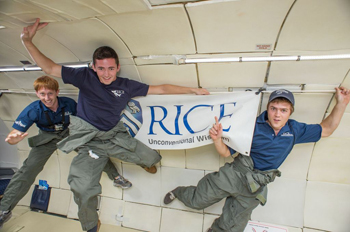Students test their position-sensing technology on NASA’s ‘reduced gravity’ program
Without gravity as a guide, it’s hard to know which way is up. But a team of Rice University students is using reduced gravity to help astronauts know which way is forward.
The team’s work in progress, an energy-efficient electromagnetic sensor to help a spacecraft accurately sense its position, could only be tested to a limited degree on campus, or anywhere on the ground. To get a proper look, the team members had to get their device as close to weightlessness as possible.

From left, Alex Kendall, Daniel Volz and Shep Patterson fly with NASA's zero-gravity program to test their electromagnetic positioning sensor. Photo courtesy of NASA
So the Rice students – mechanical engineering majors Joseph Huseman, Alex Kendall and Shep Patterson, electrical engineering major Daniel Volz and statistics and political science major Daniel Zales (with ground crew members Elliot Ghorayeb and Sam Stein) – took part in NASA’s Reduced Gravity Education Flight Program. This program gives undergraduates the chance to propose, build and fly experiments.
In late July, with support from the Rice Space Institute, the five flew a modified Boeing 727-200 popularly known as “G-Force One” to test their device in near-weightless conditions. They weren’t weightless, of course. The students were in free fall over the Gulf of Mexico as the plane took a series of steep dives from the top of an arc at about 40,000 feet and dropped nearly 20,000 feet in 25 seconds.
“It was indescribable,” Zales said. “We kind of just floated up. You can float underwater and if you tumble enough under the waves you can’t really tell which direction’s up. It felt a little like that but without the water resistance.

Members of the Rice team lock their experiment down in the modified Boeing 727 used for microgravity flights. Photo courtesy of NASA
“Motions were very counterintuitive,” he said. “In the water, you can swim along and reorient yourself. Up there, you couldn’t change your body’s orientation until you hit a wall.”
Once the sensor was prepared to fly, there was little for the students to do but enjoy the flight. “We set up the experiment so it could be largely autonomous, and we could have the experience while doing the experiment,” Zales said.
Back on the ground, the team has a mass of data to analyze from both the sensor and the aircraft’s own accelerometer. “We’re currently crunching the numbers,” he said.
The students’ invention incorporates three electromagnetic sensors surrounded by strong earth magnets aligned along three axes. According to the team, small shifts in the acceleration of a space vehicle would cause the magnetic fields around the sensors to shift; this altered the magnetic flux around the sensors and alerted the space vehicle to the change.

Five Rice students flew as part of NASA's zero gravity program this month to test their positioning sensor for long space flights. From left, NASA adviser Jessica Tramaglini and students Dan Volz, Daniel Zales, Alex Kendall, Joseph Huseman and Shep Patterson. Photo courtesy of NASA
A device to track displacement from a planned trajectory would be nice to have in Earth orbit, but the Rice students are taking a wider view.
“The technology we developed provides an alternate method to sense position rather than using traditional accelerometers,” Huseman said. “It is always nice to have another way of doing things and, pending further advancements in electromagnetics, it is possible that another team will use our design as a platform to invent an electromagnetic sensor that will be even more efficient and accurate.”
“When you’re trying to go from Earth to Pluto, you really want to know where you are, how fast you’re going and what direction you’re going in,” Zales said.


Leave a Reply